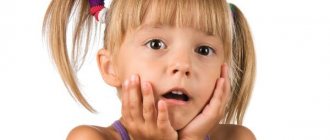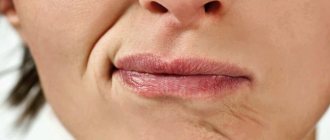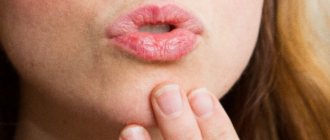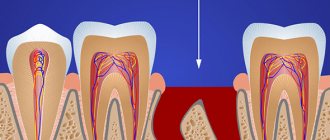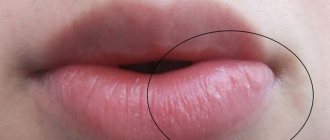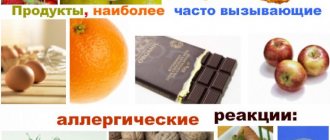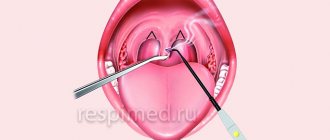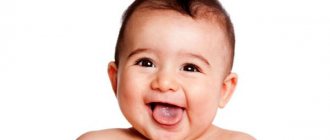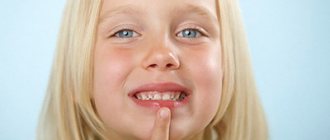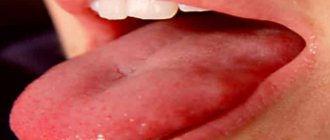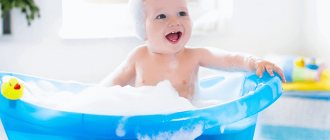April 5, 2020
Diathesis is not just an allergy, but a predisposition of the body to the occurrence of diseases and pathological reactions that manifest themselves mainly in childhood. This is a special condition accompanied by the child’s tendency to:
- to allergic reactions;
- frequent colds and respiratory infections;
- metabolic disorders;
- changes in immunological reactivity.
With diathesis, an inadequate response of the body to normal environmental influences (irritants) is observed. But such reactions occur with an unfavorable combination of several provoking factors: errors in nutrition, poor diet, improper care, frequent infections, etc.
The most common type of diathesis is exudative-catarrhal. It is this that manifests itself in the form of allergic dermatitis. The first signs appear as early as 3-6 months and can remain until 1-2 years, when in most children all symptoms of diathesis disappear.
The main signs that manifest exudative-catarrhal diathesis are:
- “gneiss” – peeling and seborrheic crusts on the scalp;
- redness, peeling and thickening of the skin of the cheeks (“milk scab”);
- itchy nodules (“strophulus”);
- diaper rash of large folds.
One of the methods of treating diathesis is local therapy.
The complex treatment of diathesis includes local therapy in the form of ointments and gels. They should only be prescribed by a specialist, and he takes this issue very seriously, since the main role in the appearance of signs of diathesis is given to allergens that affect the child’s skin.
What drugs are often included in the list prescribed by a doctor:
- To soften and quickly heal the skin: Bepanten, zinc ointment, Desitin (zinc-based ointment).
- For disinfection, softening and prevention of the formation of new crusts: Diaderm, Glutamol.
- To suppress an allergic reaction: Fenistil, Vibrocil, Cetrin.
It is worth considering that ointments are not the main way to treat diathesis, since they do not affect the cause in any way. Local therapy is used as an auxiliary method. The basis of treatment should be diet, proper care, and avoidance of contact with allergens.
Symptoms of diathesis
Inflammation of the skin during diathesis is the body's reaction to contact with an allergen. The main way an allergen enters a child’s body is food, but a reaction to contact with the skin of the allergen is also possible (the allergen, for example, can be components of washing powder that get on clothes during washing, plant pollen, dust, animal hair, etc.).
Diathesis in children under 3 months of age
The first manifestations of diathesis most often appear at the age of 2-3 months. This:
- diaper rash that does not disappear even with careful care;
- profuse prickly heat with mild overheating;
- sebaceous crusts of gray-yellow color on the head in the hairline area (seborrhea).
Diathesis in children aged 3 months and older
In older children, a typical manifestation of diathesis is red spots on the cheeks. As the condition worsens, the skin becomes crusty. The crusts become wet, the child experiences discomfort, itches, becomes excitable, sleep and appetite may be disturbed, and loose stools may appear.
Hormonal ointments for diathesis
A special group of local drugs used for diathesis are hormonal ointments. They are used if non-hormonal drugs do not help. Hormonal drugs have a more serious composition, including hormonal components - glucocorticoids. These are steroid hormones synthesized by the adrenal cortex. The most common among them are:
- Natural glucocorticoids: cortisol, hydrocortisone. Their effect lasts for 8-12 hours.
- Synthetic analogues: prednisolone, prednisone, methylprednisolone, mometasone, clobetasol. The substances act within 12-36 hours.
- Synthetic analogues containing fluoride: dexamethasone, betamethasone, paramethasone, fluprednisolone. The effect of the substances lasts up to 3 days.
Such substances have the following effects:
- Antiallergic. Hormones reduce the level of basophils - substances activated during allergies.
- Anti-inflammatory. Substances reduce the level of inflammatory mediators in the blood.
Hormonal drugs have a faster effect, but also have a more impressive list of side effects. For this reason, few hormonal ointments are approved for children, and they try to resort to them in extreme cases, when the child’s condition is advanced and he suffers from itching, large lesions and other unpleasant symptoms.
The list of hormonal drugs used for diathesis includes:
- Advantan (methylprednisolone) – from 4 months;
- Lokoid (hydrocortisone) – from 6 months;
- Afloderm (alclomethasone) – from 6 months;
- Beloderm (betamethasone) – from 6 months
- Dermovate (clobetasol) – from 1 year;
- Elokol (mometasone furoate) – from 2 years.
What are the dangers of using hormonal ointments for diathesis?
Because children have a larger surface area to weight ratio than adults, they are at greater risk for side effects from hormonal medications. With long-term use there is a risk of growth and development disorders. For this reason, children are prescribed minimal doses of ointments, as well as short courses. For example, Advantan cannot be used for longer than 4 weeks.
There are other features of the use of hormonal ointments associated with the small surface area of the child’s body. For example, Beloderm ointment is used very carefully and should never be applied under a diaper, since due to the increased absorption of the active components, the risk of developing serious side effects increases.
It is equally important to apply hormonal ointment with caution in the area of body folds. In these places, the ointment is absorbed more actively and can have a systemic effect on the body, that is, enter the bloodstream and influence from the inside.
In the case of hormonal ointments, it is also important:
- do not exceed the prescribed dosage;
- use the amount of ointment prescribed by the specialist;
- do not extend the period of use (in most cases no longer than 5 days);
- Apply only to the affected areas.
Causes
Allergic rashes can occur in children from birth until the age of 7 years. This is explained by the fact that the immune system has not yet been formed. Below are the main causes of allergic reactions in children:
- Medicines, the body may react negatively to some components of medicines;
- Breast milk if the diet is not followed;
- Hygiene products and household chemicals;
- Plants and animals can also cause rashes;
- Ultra-violet rays;
- Various infections and diseases.
What to do if a child has diathesis
Local therapy using ointments is one of the components of complex treatment. But both hormonal and non-hormonal drugs should be prescribed by a doctor individually for each baby, taking into account the characteristics of the diathesis.
Self-medication in such a situation is not only ineffective, but also dangerous for the child’s health. Therefore, it is better to contact competent specialists. PsorMak employs doctors with extensive experience in treating diathesis.
We take a comprehensive approach to diagnosis and treatment, and for local therapy we use ointment made according to our own recipe without the addition of hormones.
She has been helping our patients at our clinic for more than 25 years, so we guarantee a complete cure without side effects. Contact us for a consultation so we can begin solving your problem. April 5, 2020
Author of the article: dermatologist Mak Vladimir Fedorovich
What do allergic rashes look like?
There are a large number of types of allergy rashes in children, it all depends on the irritant that caused it. In many cases, exanthemas appear on the child’s body (this is the name given to various manifestations of allergic rashes):
- pustules (filled with pus);
- plaques;
- spots;
- vesicles (filled with liquid);
- blisters (large vesicles larger than 0.5 cm).
With food allergies in children, the rash can be found primarily on the cheeks and near the mouth. With a contact allergy, a rash or irritation will appear in the area where the allergen touched. If the child’s body reacts negatively to medications, inflammation will appear in the area of the lymph nodes.
First aid and treatment
If children develop an allergic rash on their skin, it is strictly forbidden to squeeze pimples or open blisters. It is necessary to explain to the child that it is also forbidden to scratch the sores.
If he is still too small, make sure that he does not touch the wounds with dirty hands. He can get an infection, and this will only worsen his condition.
Treatment of rashes in children is selected depending on the type of disease. Parents who do not know how to treat allergic rashes in children should not select medications on their own.
Neonatal acne in newborns
Newborns include children up to 28 days of life. Some mothers notice irritation on the baby's skin during this period, which makes them worry. This condition is typical for 20-30% of children and refers to physiological phenomena.
A rash around a child’s mouth is a consequence of hormonal changes in the body, which begins to live independently.
The second reason for the phenomenon is the proliferation of yeast-like fungi on the surface of the body, which need sebum for nutrition. Externally, it is not difficult to determine that this is acne of the perinatal period. The elements are pointed, with a white shaft in the center. The contents of the vesicle are viscous, which distinguishes clear discharge from herpes infection or dermatitis.
Unlike other causes of its appearance, newborn acne migrates over the face and neck and is not typical for other parts of the body, as with urticaria and miliaria. In addition, there are no signs of intoxication, which would indicate an infectious process.
How and with what to treat?
For any type of rash around the mouth, you should consult a specialist who will determine the cause and prescribe treatment.
If children of different ages have pimples in the corners of their mouths, then you should not delay a visit to a pediatrician or dermatologist. The specialist will find out the cause of the disorder and select the necessary therapeutic measures. Treatment is adjusted for each patient individually, taking into account age, type and severity of the rash. If the source of the problem is atopic dermatitis or allergic manifestations, the allergen that negatively affects the baby’s health is removed from the diet. If this measure does not help, then antihistamines may be prescribed.
When an allergy occurs during breastfeeding, the nursing mother needs to review her diet and exclude all foods that can cause acne around the mouth.
When the problem is caused by the herpes virus, antiviral therapy is carried out with a choice of individual medications suitable for the patient’s age. For medicinal purposes, you can use ointments, gels, sprays or oral medications. In the fight against acne formed as a result of enterovirus infection, antibacterial drugs are required, which are prescribed exclusively by a doctor. A rash associated with helminth infection is eliminated by deworming the body with the help of special drugs.
How to avoid allergies in children?
Preventive measures will prevent the child from developing an allergic rash. Doctors give the following recommendations:
- Make sure that the baby does not come into contact with the allergen (remove allergenic foods from his diet; if necessary, change baby powder, soap or dishwashing liquid.
- Maintain order in his room, regularly do wet cleaning.
- If there are pets in the house, keep them clean.
- Strengthen the baby’s immunity (walk more often, play sports).
- Do not violate your doctor’s recommendations for taking medications.
Other causes of rash around a child's mouth
If there are no signs of allergies, dermatitis or enterovirus infection, then the appearance of irritation may be associated with individual characteristics of digestion. In this case, the child has unstable stools, a tendency to constipation, and particles of undigested food in the stool. This may occur due to inappropriate nutrition for the child's age.
The most common cause of the disorder is infection. The aggressive factor is staphylococcus, an element of normal microflora. With hypothermia and decreased immunity, it begins to multiply on the skin, causing a pustular rash on the face and other parts of the body.
Fungal flora also reacts to decreased immunity. If the mother had thrush during pregnancy, which was not completely cured at the time of birth, then candida remains on the surface of the body and can appear at any time. A sign of a fungal infection is the presence of white or yellowish patches that peel off when rubbed.
If there is a strong wind outside and the face is not protected, then foci of peeling appear on the chin and in the perioral area. This is caused by chapping of the surface of the skin.
Violation of personal hygiene rules is an additional factor in changes in the condition of the protective cover. If you touch your mouth with unwashed hands, bacteria begin to multiply on the mucous membrane.
Other reasons may be:
- allergy to the latex from which the pacifier is made;
- consequence of vaccination;
- insect bite
The main sign indicating the category of rash is the nature of the rash and the presence of auxiliary symptoms.
